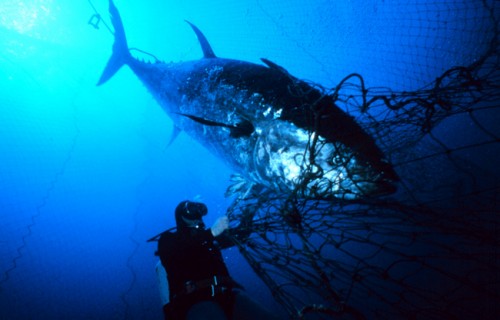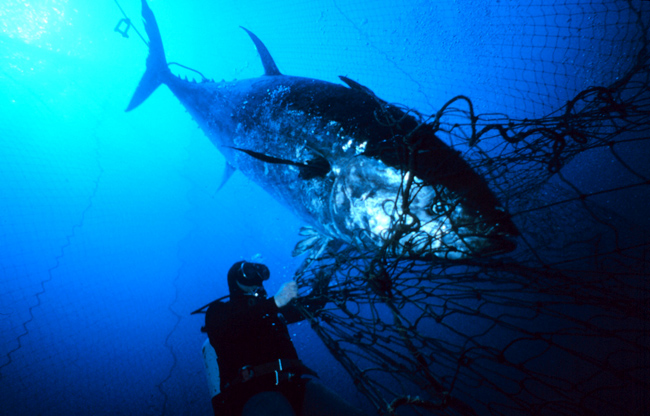
In Checkout Line, Lou Bendrick cooks up answers to reader questions about how to green their food choices and other diet-related quandaries. Lettuce know what food worries keep you up at night.
Hi there,
I am desperate for a tuna melt with some chips on the side, but am living in fear for my insides with the possibility of mercury in the fish. I see “tongol” tuna in cans at my local high-end market and at the local co-op, so I’d like to make the assumption that this is somehow better for me, but I know that you will enlighten me and all of those others missing the foods of our youth…
Missing the Fish
Dear Missing the Fish (and all of you who are missing the foods of your youth),
It’s definitely a big bummer when you realize that your childhood comfort foods are not only potentially hazardous to your health, but also environmentally dicey. In tuna’s case, it contains mercury and it’s also sometimes fished in unsustainable ways. Um, dolphin-killing ways.
But don’t fret. It’s my job to rebuild your favorite meals by making them better for your “insides,” and for the outside (that is, the planet). Oh, and delicious too. Excuse me for a moment while I get my magic pixie wand.
While I look for it, here’s the canned tuna backstory:
• Mercury isn’t just a possibility in canned tuna; it’s a reality in every bite. Industrial polluters such as coal-fired plants pump methylmercury into our air. This stuff then falls from the sky and makes its way into our waterways, where it accumulates in fish that we eat. Big, longer-living fish and fish at the top of the food chain, such as tuna, accumulate more methylmermercury.
• While the fact that methylmercury is bad for us isn’t disputed, no one really knows how much of the stuff it takes to harm any given person. “There has never been a blinded, placebo, controlled study giving humans methylmercury to discern its effects over any length of time,” explained Jane M. Hightower, M.D., by email. “I doubt an institutional review board would consider such an experiment as ethical, yet you can buy all you want at your local grocery store without informed consent.” Hightower, who is widely acknowledged as the first American physician to recognize low-level mercury poisoning in patients who regularly consume certain types of fish, wrote the recently released book Diagnosis: Mercury.
• Not surprisingly, the FDA consumption guidelines for limiting methylmercury from canned tuna seem like a bit of a crapshoot. “Moms and Moms to Be” are told that canned light tuna is a low-mercury fish, but to limit it to 12 ounces per week whilst feeding kids “smaller portions,” which seems outrageously vague given that methylmercury can harm kids’ brains. They also advise limiting albacore tuna to six ounces per week. Is this stringent enough? There’s confusion, even among our governmental agencies. “The FDA is in charge of commercial fish, but has not completely adopted the EPA’s determination that individuals keep mercury consumption to less than 0.1 microgram per kilogram of body weight per day, ” according to Hightower.
• Meanwhile, who the heck knows how much mercury you are actually getting in any can of tuna. Defenders of Wildlife tested cans of imported tuna and found that one in 20 cans were unfit for human consumption, according to the FDA’s standards.
• As I mentioned, tuna has problems beyond mercury. If you don’t see information about fishing methods on the can or package, assume that deadly-to-wildlife methods, such as purse seining or, worse yet, long-lining, were used. To read more about fishing methods go here.
• Dolphins are still dying for our tuna salad. Although the rate of dolphin slaughter slowed significantly because of the fishing industry’s response to public outrage, dolphin populations are not recovering well (in the immortal words of Doug Adams, “So long and thanks for all the fish!”). For dolphin-safe tuna, look for this official Earth Island Institute Dolphin Safe logo. Other so-called “dolphin-safe” labels lack their rigor. Sadly, no label can guarantee that dolphins are truly safe when it comes to fishing for tuna.
Okay. I found the pixie wand. Let’s see if it can revive your appetite with two options.
Option #1: Use minimal-mercury, sustainably caught tuna. This tuna typically comes from younger tuna that hasn’t had time to accumulate lots of methylmercury. (This is why canned white albacore tuna, which comes from bigger, older albacore, is higher in mercury than light canned tuna, which tends to come from younger, smaller skipjack.) Wild Planet, Eco Fish, and Vital Choice are a few brands to try. Sustainably caught tuna is pole, troll, “hand” or line-caught. Also be sure to use your hard-earned dollars to reward companies that conduct independent testing for mercury and PCBs, and that use BPA-free cans. This stuff will be more costly than your average can of tuna, but the alternative is brainkill-noodle casserole.
Option #2: Ditch the tuna altogether and use sardines, which may be making a culinary comeback. The biggest taste problem with tuna is that it tends to be dry. (Remember the tongol you mentioned? It’s a species of tuna that tends to be moister and therefore popular. The Monterey Bay Aquarium ranks most tongol as a fish to “avoid” because of high levels of bycatch and poor enforcement of fisheries regulations.) But dryness isn’t a problem for sardines, which are not only oilier, but also lower on the food chain, low in contaminants such as mercury, and high in the always-popular omega-3 fatty acids. According to Hightower, “If one consumed a low-mercury fish such as sardines or salmon, only two ounces would be needed to give adequate omega-3 intake for a day. If you consumed four ounces of it, you would take in on average, 3 mcg of mercury for that meal, and still have room for another equally low mercury meal for that week.”
But will you like the taste?
In the name of science, I made two batches of melts using this classic diner recipe for my tuna-loving friend, Kim. One batch contained tuna; the other skinless, boneless sardines packed in water. While Kim admitted that the sardine melt was fishier tasting, she said it was close enough to tuna to convince her to make the switch. More incentive: With this mercury calculator, I used Kim’s weight to calculate that if she ate a six-ounce can of albacore tuna, she had consumed 140 percent of the EPA’s suggested safe mercury consumption, whereas the same amount of sardines put her at a mere 10 percent.
The catch (pardon my pun)?
Kim didn’t think her kids would go for the sardines.
It’s time to enlist my savvy, tireless readers, or Jessica Seinfeld, to post some deceptively delicious sardine recipes. In the meantime, to go with your melt, check out which sustainable chips Grist found most delicious.
Until then, for the love of God, please don’t ask me about meatloaf,
Lou
PS: For more information about the different species of tuna, consult a seafood watch list. You can also get text information on your cell—handy when you’re pondering a restaurant menu or grocery store cold-case—by using the FishPhone.



